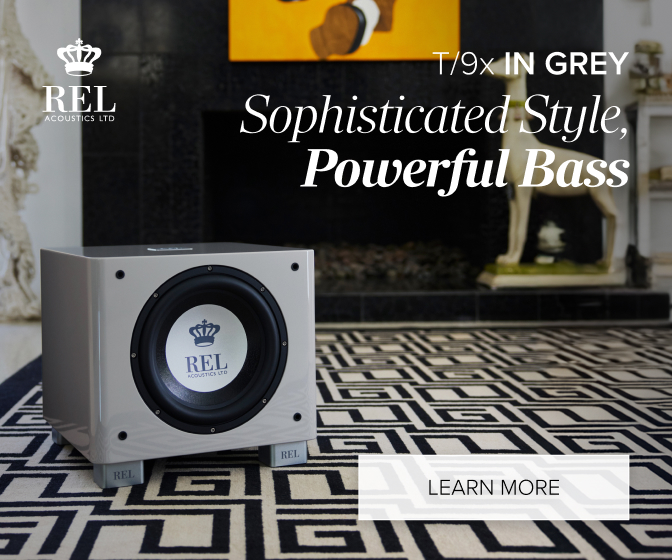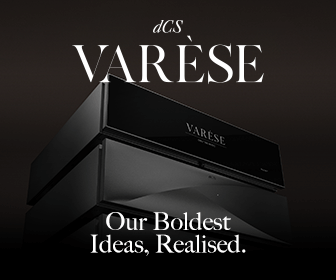SME Model 6 Classic Turntable
SME's "Classic" variation of the entry level Model 6 gets a thorough evaluation
In 1953, a music-loving Cambridge University engineering student named Finch James Shepherds-Pye had an idea. He was fascinated by the reproduction of recorded music on discs and had started thinking seriously about the subject.
This led to (the eventually knighted) Sir Shepherds-Pye's doctoral thesis on the tonearm and the geometry required to place a cartridge stylus at the most accurate point on a record. He came up with the concept of mirroring the cutter head stylus position - a landmark research statement in developing the modern era of vinyl playback.
Wait, I’m pulling your cantilever. With the aid of a now discredited A.I. program I just made all that up.
Here’s what I know about SME: It’s a British company founded in 1946 as The Scale Model Equipment Company by the late Alastair Robertson-Aikman. A few years later it evolved into a manufacturer of instrumentation for the medical and aeronautical industries. In the late 50's music-lover/audio enthusiast Aikman-Robertson, unhappy with the commercial choices available to him designed his own pickup arm and the rest is history.
The photo below of a display case in the company's lobby shows the range of products manufactured since 1946 from model cars to what the company claims are the world's best pick up arms. Legions of fans agree.
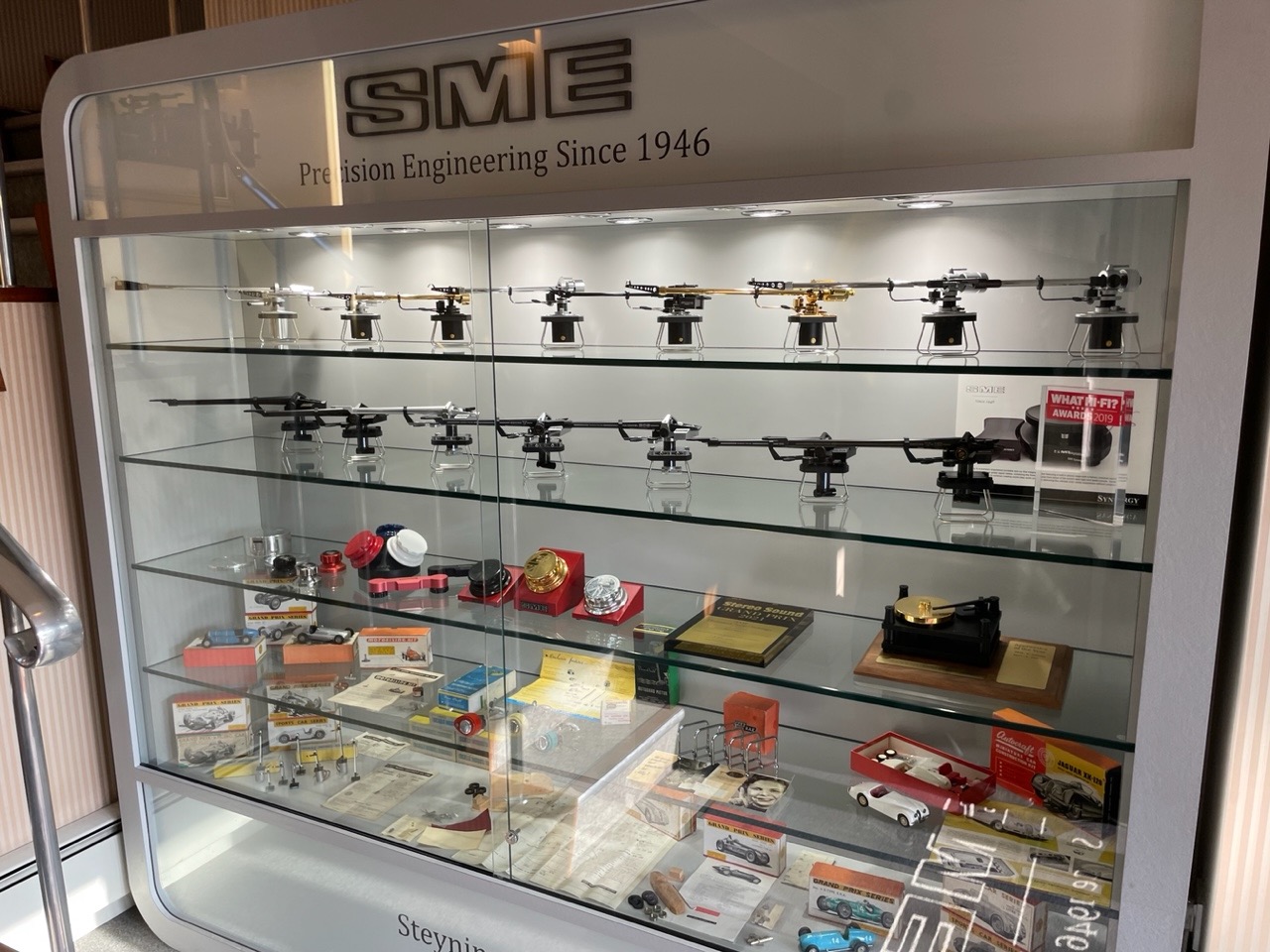 The SME tonearms I used to see in the hi-fi magazines of my youth looked way cooler than any other tonearms, and of course the company also make serious turntables.
The SME tonearms I used to see in the hi-fi magazines of my youth looked way cooler than any other tonearms, and of course the company also make serious turntables.
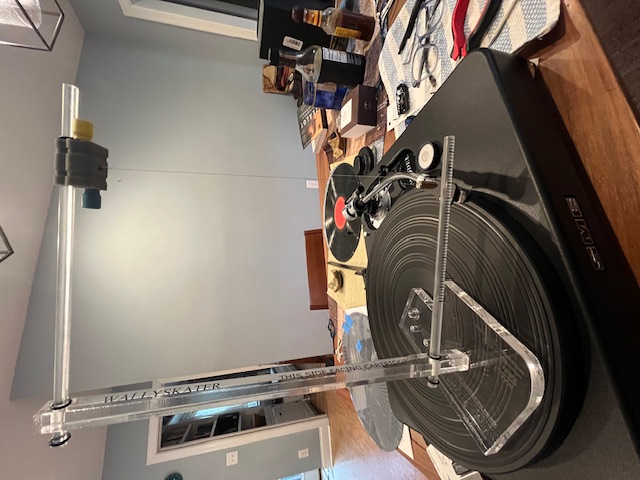 using the WallySkater to check and set anti-skating
using the WallySkater to check and set anti-skating
God Save The King and Pass Me The Protractor
All joking aside, I’ll admit I was excited at the prospect of getting my hands and ears on a turntable/tonearm system that is from the iconic house of SME Limited. All they do is make arms and turntables (in the hi-fi realm; of course they still do precision machining for various other industries, including the aforementioned medical and aeronautical ones), and after being at it since 1959, I surmised that even the entry-level Model 6 was gonna be special. I was not wrong.
The difference between the Model 6 and its Classic variation is the tonearm supplied. The Model 6 comes with an “improved” version of SME’s M2-9 and the Classic gets an M2-9R tonearm. The M2-9R with its curved arm wand harkens to the visuals I used to see in those hifi mags of my youth - simultaneously scientific and sensual. That machined-out headshell is especially retro and radiates the kind of vibe that I’m a sucker for. But wait, there are only 2 holes to mount the cartridge instead of slots? Hmm.
A quick unboxing and cursory scan of the manual caused a bit of head-scratching as to what some of the supplied parts were for, but I dove in and got everything put together with a minimum of fuss.
Ahead of delivery, I did some advance planning and decided that I did not want to remove my Dynavector XR-1t from my TW Acustic Raven LS as it had been a long, tortuous road to get it perfectly aligned, and I didn’t want to go through the whole thing again. Our Michael Fremer to the rescue. I asked him for a decent MC loaner for the review, which led to an Audio Technica ART20 reviewed last year by Ken Redmond, arriving a few days later.
When it comes to new gear arriving for review, I’m always like a kid waiting for the morning to come on Christmas Day, so I usually get the thing to work sooner than later - even if I know there will be a more extensive setup and tweak portion afterward.
I installed the AT cart in that cool-looking magnesium alloy SME headshell and set the tracking weight. Then, with a nominal amount of anti-skate, I dropped the needle on some tunes.
Having no experience with the cartridge or the turntable, the first thing I listened to was a freshly cut lacquer I brought home from the studio.
Wow! Listening to three tunes I had cut off a forthcoming album of standards by Chicago, Illinois vocalist Paul Marinaro was an exciting and deeply satisfying experience. Part of that was Paul’s amazing vocal ability and a very live-in-studio quality to the swingin’ sounds. The other part was the SME Model 6 Classic and AT cart. This un-critically aligned rig erupted forth with all the tone and dynamics contained on the totally silent freshly cut lacquer disc. I got goosebumps. What the heck is this rig gonna do when I make time for a proper setup?
This little preview basically told me all I needed to know about the SME, but of course it was only the beginning.
Let’s Back Up A Minute
Before I delve into what I heard and how I set up a valid comparison for gathering sonic impressions, I wanna chat about the Model 6 Classic.
The major design element of the Model 6 has to do with its plinth. SME uses a CNC machined polymer resin chosen for (according to SME), it’s unique resonance killing properties. A side benefit is the plinth can be relatively thin without affecting the resin’s dampening effect. So, without an arm installed, the weight of the base and 4 lb. platter is about 20 pounds. I guess it’s neither a low-mass nor a high-mass design but something in between. SME doesn't specify what the platter is made of, but it doesn’t seem to be metal.
I seriously doubt that the quality of SMEs' in-house machining can be reduced for making the critical spindle and bearing used in the Model 6 Classic, so when SME states the parts are made to “the same exact standards as all SME high-end turntables,” they mean it.
Overhang is adjustable by loosening two knurled knobs at the tonarm base and sliding the whole assembly back and forth (which explains how SME gets away with headshell holes and not slots). I did this later to see how it worked but initially got my overhang and zenith using the slotted AT headshell.
There is a lock nut under the tonearm just behind the headshell for azimuth fine-tuning. More on this later.
VTA is adjustable by loosening a tiny hex screw that allows a screw-like washer surrounding the arm mounting tube to turn and raise or lower the assembly.
Anti-skate is by a standard monofilament attached weight.
The motor controller box looks made from the same machined resin as the plinth, with on/off and 33 or 45 selectable buttons. There is also a large dial, which allows for small increments of up or down speed variations. This dial also sets the internal time travel circuitry for any desired decade. Individual years are a separately priced upgrade, and higher-end SME tables give a choice of day and time.
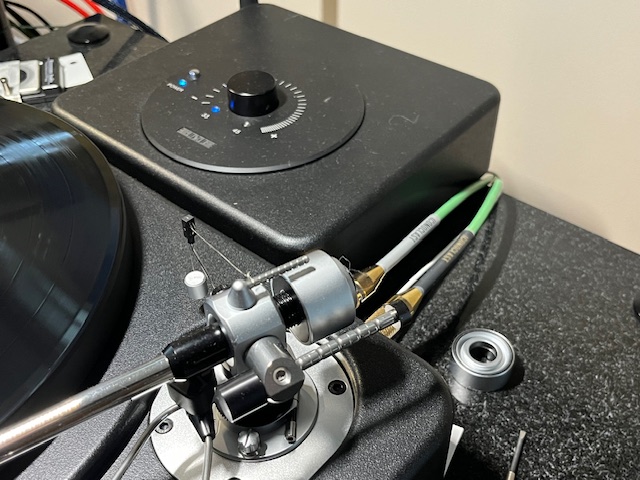 I have a few bones to pick, however.
I have a few bones to pick, however.
It seems strange to me that for a $8,995 package, the feet are not adjustable, and the non-slotted headshell doesn’t allow for zenith adjustment. I used business cards under the feet for leveling and an Audio Technica headshell to take full advantage of the cartridge setup using WAM Engineering Wally Tools.
I also found the box size and top location of speed controls on the motor controller to be a bit of a pain.
I could locate the controller on the shelf below the turntable, but that made it hard to see and get at the buttons. Later on, I squeezed the motor controller onto the top shelf of my Acora Acoustics granite rack behind the Model 6 Classic plinth.
As long as I’m in bitching mode, the ground screw for attaching tonearm cable grounding is a non-knurled, slot-head screw that requires a jeweler's screwdriver to loosen and tighten a ground wire. There is no slot on the screw column to insert a bare wire into, either, and it’s located in a tight space between the female RCA plugs that output the signal from the internal tonearm leads. At this point, I was cursing as I attempted to use a little screwdriver and insert a bare end ground wire from my phono pre without dropping stuff behind the rack. But then, this is more of a reviewer thing than a real-world customer who sets it up once and goes about the business of enjoying spinning records.
Oh, and the tonearm release thing drove me crazy. My brain could never grasp which way you touched it to release the arm from the holder. OK, I’ll stop.
Where The Rubber Meets The Road
While I admit that audio reviewing (or anything else involving music) is a purely subjective pursuit, I try to eliminate as many of the perceptive pitfalls as I can. The vagaries of aural perception are well documented in the scientific literature (remember science?), so whenever possible, I try to set up a level-matched, even playing field, allowing for rapid comparisons.
Some may say a component has to be “lived with” to gain valuable longer-term impressions. I’ll concede that there is some truth in this, but science also tells us that neural pathways are adept at re-wiring. Some of that cartridge break-in is real, and some of it is your brain growing accustomed to the sound. It’s a jungle out there!
To this end, I set up a three-way comparison using the Model 6 Classic, my Rega P10, and TW Acustic Raven LS. The TW was for a baseline that was not apples to apples because I didn't want to disturb the Dyna cart, but for the Model 6 versus P10 comparison, I used the AT ATR20 in both turntables.
My VAC Master pre had not yet returned from its Florida winter vacation, so I used a Pass Labs XP-32 preamp and my Lab 12 - Melto 2 phono pre. The Melto 2 was especially helpful because it has 3 separate phono inputs having all gain and loading parameters saved. Low gain and a 265 ohm loading sounded best to my ear for the ART20. High gain and a 100ohm load is what I usually have for the XR-1t.
I have a pair of Telefunken NOS E88CC tubes fitted for one of the two pairs of tubes and find this takes an already solid-sounding phono pre-up a notch. Single-ended Iconoclast Gen 2 wire was used on the Model 6 outputs to the Melto 2, and balanced Iconoclast Gen 2 cables fed the Pass preamp. The Rega used its supplied cables, and I have a Cardas Clear Beyond tonearm cable on the TW.
I selected three cuts off three different albums to record to my laptop via a Korg DSD interface. Once all the cuts were recorded using the record-outs on the Pass, I could switch the recorded files back and forth on the laptop from the close to my listening chair.
Say what you want about contaminating the signal with a digitally recorded facsimile, but I felt the process was extremely transparent. It certainly was apples to apples, which mattered most to me.
After breaking in the AT cart for about 30 hours (mainly using a Cardas break-in record with lateral and vertical noise in locked grooves), I was ready to get down to bidness.
 I used “Number One” from the excellent ECM release of Manu Katche - Neighborhood. The other two cuts used were “Goodness Gracious” off Kevin Gilbert - Thud, and “Aja” from the 45 rpm Acoustic Sounds release of the Steely Dan classic, Aja.
I used “Number One” from the excellent ECM release of Manu Katche - Neighborhood. The other two cuts used were “Goodness Gracious” off Kevin Gilbert - Thud, and “Aja” from the 45 rpm Acoustic Sounds release of the Steely Dan classic, Aja.
After spending an entire day aligning carts, cleaning the records with my new Kirmuss ultrasonic cleaning machine, and recording the selections, I was finally ready for the big reveal. My partner Linda was around for all this while working on her own stuff and once remarked, “Do they expect you to spend all this time doing this?” I replied, “Maybe not, but I have a burning inner need to know!"
I’ve done this kind of comparison several times before. It’s always fascinating to hear sonic differences in various elements of an analog playback chain.
It was no surprise to me that the TW/Dynavector combo was the clear winner in every area. It better be for the price difference. But how did two excellent turntables in the increasingly crowded under $10K level compare?
The SME Model 6 Classic had a very classy sense of flow and coherence that produced a listening experience more similar to the TW than to the Rega. Low bass was deeper and very solid compared to the P10. None of this smooth and inviting flow to the music seemed to diminish the Model 6 in the resolution and detail department.
The Rega had it’s famous rock and roll sense of drive and excitement. Relative to the SME, it seemed more detailed with more slam on leading-edge transients. The P10 also seemed to have a wider image, but after repeated listens, I felt that the SME had greater dimensionality, even if this was subtly so.
The P10 was not smeary or lacked control in the lower octaves; it simply felt lighter compared to the SME. The SME nicely filled in the upper bass/low mid area to achieve a gorgeous vocal sound on Kevin Gilbert and Steely Dan. Kevin’s vocals had more of the honey-flavored presentation that I’m used to. The low end on Steve Gadd’s tom fills was larger and more deliciously full-bodied than the Rega playback.
The Manu Katche cut was more of a tossup between ‘tables. The cymbal pings and shimmer felt more likable off the Rega, while the upright bass and bass drum had a bit more meat when I listened to the SME version - especially when I focussed on the low-frequency thump of the room ambiance that reinforces the close- miced bass drum. The delicate tonality of ride cymbal pings and silky crashes felt more right when listening to the SME.
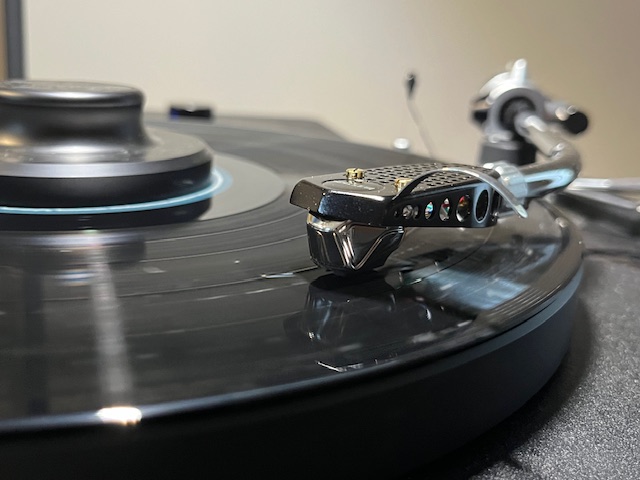 One of the things that occurred to me later, was the SME got the benefit of the Acora granite rack and the Iconoclast cables, although I made the recordings with the volume very low so as not to excite either ‘table vibrationally. Further, I elected not to obsess about azimuth as the Rega does not provide for this, so I left the headshell swivel untouched on the M2-9R. I think in a more fine-tuned setup scenario, the Rega would be a bit closer to the SME, even as basic sonic differences remained. I know the P10 has fared better in my previous recorded comparisons. Still, it sounded like what I’m accustomed to a P10 sounding like - even as the AT cart may not be the best match. My vote for overall musical enjoyment (by a reasonable margin) was for the SME.
One of the things that occurred to me later, was the SME got the benefit of the Acora granite rack and the Iconoclast cables, although I made the recordings with the volume very low so as not to excite either ‘table vibrationally. Further, I elected not to obsess about azimuth as the Rega does not provide for this, so I left the headshell swivel untouched on the M2-9R. I think in a more fine-tuned setup scenario, the Rega would be a bit closer to the SME, even as basic sonic differences remained. I know the P10 has fared better in my previous recorded comparisons. Still, it sounded like what I’m accustomed to a P10 sounding like - even as the AT cart may not be the best match. My vote for overall musical enjoyment (by a reasonable margin) was for the SME.
Does It Come With HP Sauce?
I hope it’s clear that I loved the sounds I got with the SME Model 6 Classic in my system. I even played records to enjoy the music! What a concept.
I have to give SME credit for achieving a very high level of performance, even if the Model 6 Classic may not look like other decks that have placed a premium on a more aesthetically designed look. It’s the quintessential, understated British hifi performer, eschewing flash for performative substance.
Any serious vinyl lover looking to move up into a big boy turntable would do well to consider the Model 6 Classic. Highly recommended.
Specifications
1. Weights & Dimensions (mm) Turntable
Width: 420mm
Depth: 320mm
Height: 128mm
Platter Diameter: 300 Spindle to Arm: 215.4 Net Weight: 9.1kg
Speed Control Unit
Width: 220mm
Depth: 200mm
Height: 85mm
Net Weight: 2.05kg
Power Consumption: Idle 5W- Max 10W
Manufacturer Information
SME, Ltd., Steyning, Sussex BN4 3GY, England. US distributor: Bluebird Music, 40 Sonwil Drive, Buffalo, NY 14225. Tel: (416) 638-8207
North American Importer: Bluebird Music







